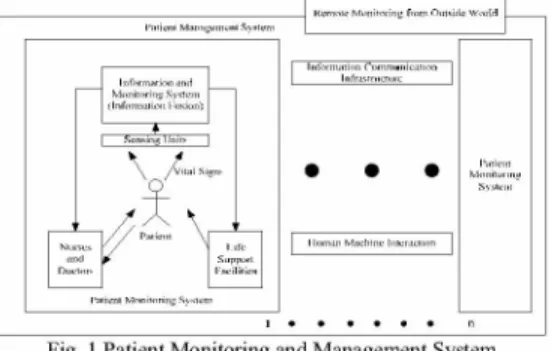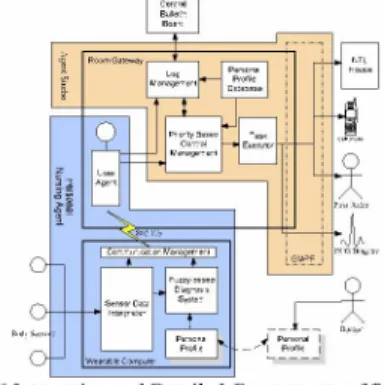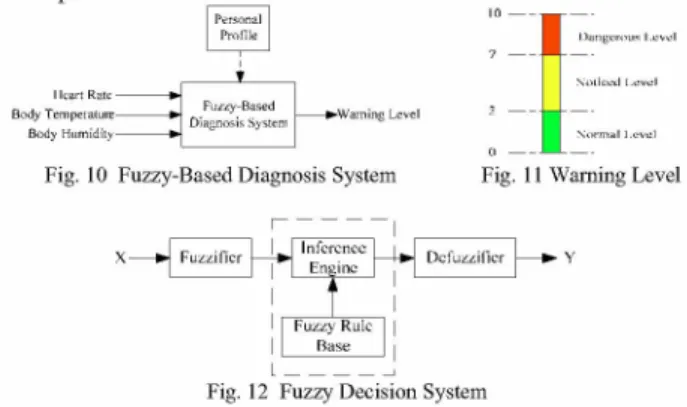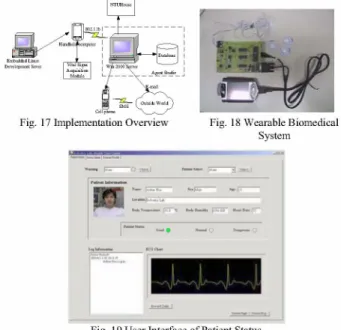Development of
a
Wearable Biomedical Heath-Care
System
Han-Pang Huang 1, and Lu-Pei Hsu2
'Correspondence, Professor ofDepartmentMechanicalEngineering,National TaiwanUniversity, 106, Taipei, Taiwan E-mail. hanpang@,ntu.edu.tw, TEL/FAX. +886-2-23633875
2Graduate studentofGraduateDepartmentMechanicalEngineering,National TaiwanUniversity, 106, Taipei, Taiwan
Abstract-Thispaper develops a wearablebiomedical health-care system which incorporates the wearable computing
technology with multi-agent software architecture to provide a
solution to the medical-care problems. The embedded Linux
based wearable medical computer connects various sensors
which can detect the patients' vital signs, such as
electrocardiogram (ECG), bodytemperature, andbodyhumidity.
Inorder to get morereliableand accurateinformation,the
multi-sensor fusion algorithm is employed to integrate the sensor
information.Thefilterbanks basedQRScomplexand heart beat
detection algorithm, and fuzzy fusion algorithms are
implemented to construct the diagnosis system of this wearable
biomedical computer. Furthermore,the PersonalNursing Agent (PNA) andmulti-agent basedinfrastructure formodern patient information and management system will be developed. The
experimental results show thatthissystem ishelpful and useful formanagingandmonitoring patients. Accordingly,the wearable
biomedical health-care system is regarded as a highly efficient biomedical system and inherits both features of multi-agent architectureand wearablecomputing, i.e.,decentralized, reliable,
autonomous,unrestrictive,andcooperative features.
Index Terms-wearable, electrocardiogram, embedded Linux, and PNA
I. INTRODUCTION
Since the twenty-first century, aging population is emerged as a preeminent worldwide phenomenon. The large proportion ofelderly population leads to a series of medical problems, such as inadequate medical care resource, low quality of medical service. These incoming problems have strong impact on hospitals and nursing homes. It is getting moredifficulttoprovide good health-careprograms for those patients.Moreover,insufficientamountsof doctors andnurses can not monitor these large numbers of elderly people who have unstable health conditions. In order to solve these medicalproblems, thispaperdevelops awearable biomedical health-care system whichintegrates the wearable computing technology and multi-agent software architecture. This system improves the traditional bedside patient monitoring system that is only usedin ICU(intensive care unit). Theproposed biomedicalsystemprovides modularized functions and has the capability ofmonitoringmobilepatients.
In the past, many researchers were focused on the development of home automation and wearable computing fields, but few of them triedto integrate these two fields. In
this paper, home automation software architecture and wearable computing areintegrated and appliedtothe medical institutions for improving their present medical health-care systems. Multi-agent architectureisadopted and implemented inthis medical health-caresystem.Thepersonalnursing agent concept isproposed. Thisagent serves as apersonalnursethat monitors a patient's health condition 24-hour a day. The embeddedLinuxbased systemwhichwirelessly connects the patient information and management system is constructed. The vitalsigns acquisitionmodules areimplemented, suchas ECG acquisition module, body temperature sensing module, and body humidity sensing module. Multi-sensor fusion technology is applied to this biomedical health-care system. The filter bank based QRS detectionalgorithmisimplemented toprovideahighaccuracyheart beatdetectiontechnique.
This paper is organized as follows. In section 2, an integrated architecture for health-care system is proposed. Thissystem isusedtoimprovethe traditional bed-sidepatient monitoringandmanagement system. Theimplementation and experimental results of the wearable biomedical health-care system willbepresentedinsection3.Finally, conclusions are given in section4.
II. INTEGRATED ARCHITECTURE FOR 24-HOUR
HEALTHCARE SYSTEM
Patient monitoring andmanagementhas beenaresearch topicforyears.As showninFig. 1,patient management and monitoring system can be divided into two major research components: patient monitoring system and patient management system. Ingeneral, thepatient monitoring system is bedside medical monitoring system and only in charge of single patient. Meanwhile, the patient management system manages all hardware and software infrastructures in a building such as hospitals. Thepatient monitoring system is
composed of four units: sensing units, information and monitoringsystem, lifesupportfacilities, and physicians. This monitoring system is aclassical bedside medical monitoring instrument. The vital signs from the patient are sensed,
amplified, filtered, and acquired. Afterward, these signals in the information fusion blockareprocessed by algorithmsthat allow,inasomewhat limitedmanner,waveform detection and delineation. Events are also detected and alarms are then triggeredintermsof different levels. Theseprocessed signals
stored in the database. Watrous described aneural network
ECG monitoring algorithm to reduce the number of ventricular and normal beats classification errors [15].
Muhammad proposed an algorithm based ondigital filtering,
adaptive thresholding, statistical properties, and differencing of local max-min for real-timemeasurement of the fetal and maternal heartrates[5].
0 0 _ S,zlie>-[l-0il-t
Fig.1Patient Monitoring and Management System
Although there are many relevant researches on the
development of biomedical systems, they seldom address the whole architecture ofpatient monitoring andmanagement. A
review paperwrittenby Mora reported the relevant works on
patient monitoringandmanagement systems [9]. Itcoversthe
traditional bedside patient monitoring, some medical
information fusion flow and algorithms, and detailed information analysis. But the report does not mention about the whole architecture as depictedin Fig. 1. Compared with
other researches, Varady [13] proposed an architecture for
patient monitoring which focuses on the development of an
industry standard based architecture to provide an open and
standard system. The patient monitoring and management architecture described aboveis atypicalconceptthatcanmeet most requirementsingeneral medicalinstitutes.However, the
patient monitoring system in Fig. 1 is a bedside monitoring
system and is useful only when patients lie on the bed.
Emergency might occur while patients are not lying on the
bed. In otherwords, theprevious architecture is not suitable formonitoring "moving"patients.Moreover, themanagement functionality of that architecture will be failed if most of patients do not lie on the bed all day. Obviously, the
management system is not workingin this case. As aresult,
theability of mobilitymanagement should beoneof themain
concerns inthe modern patient monitoring and management
system.
A. Multi-Agent Architecture for Health-Care System Inordertoprovideasafe andconvenient environmentfor patients who livein hospitals andnursing homes, the patient
monitoring and management system should have the following features:
* Full-time health condition tracking: Somepatients might
breakout sometimesbecause of their unstable physical conditions. These unpredictable accidents may cause
sudden death. The system should inform medical personnel immediately when the accidentsoccur.
* Reliability: This system manages important facilities in the building. It can not crash due to failure occurred in the sub-system.
* Autonomous: Due tolimited number of nurses, the system should give apreliminary diagnosis tohelp nurses and doctors monitor the health conditions of patients. The multi-agent system is a highly efficient system which provides reliability and extensibilityinanautomation system. Thus, this paper adopts the multi-agent architecture to fulfill the needs ofpatientinformation andmanagement system. On-line monitoring of the patients' conditions is the most important characteristics in the health-care system. In the proposed architecture, it also provides a mobile monitoring device whichisworn onthepatient.This wearable devicecan gather the vitalsigns, which areECGsignal,heart rate, body temperature, and body humidity. Medical personnel can monitor and act appropriately according to these vital signs. Theoverviewof the proposed architectureisshowninFig. 2.
t N
Fig.2Overview ofProposedArchitecture
The
proposed
system consists of threemajor
components:
personal
nursing agent(PNA),
agent studio and central bulletin board,asshowninthe'The system can be further divided into several zones.
Eachzone represents an
independent working
group and cancommunicate with each other via the central bulletin board. The central bulletin board is a
place
where every componentof the system announces its messages and records important system informnation such as alarmnmessages. A zone consists of an agent studio and several
personal
nursing agents and works as a smallmulti-agent
system. In other words, anindividual zone is a
complete
system and can work well without others. In thehospital
whichadopts
thisintegrated
architecture,
generally,
a zone represents an individual roomandis
regarded
as acontrol space. Apatientwho lives inthehospital
can wear amobile device whichis apartofpersonal
nursingagent. The
personal
nursingagentcarriesthepatient's
personalinformationsuchasIDand
password.
B. Collaboration betweenPersonal
Nursing
AgentsandAgent
StudioEach room is treated as a zone in the
proposed
architecture and each
personal
nursing agent represents apatient
intheroom,as shown inFig. 3 and Fig. 4. The agent studiomanages
room devices andpersonal
nursingagents.
Itcommunicates with the
personal
nursingagents through
IEEE 802.1lb wireless networkprotocol.
The agentstudio canturn:"-on and off the lights and adjust the air conditioner to the desired temperaturewhen the agent studio receives acontrol command either frompersonalnursing agent orfrom the agent outside the zone. Once personal nursing agent sends the registercommandtotheagent studio, theagentstudio checks the IDandpassword sentfrom thepersonal nursing agent. If registration is successful, the agent studio will send the registrationinformationtothe central bulletin board.
Qdtid&
i.AL
PNA V sAle rt \/ 1 gFEr.[ 802.1lb Aii PNA Conditioner PNA H [.ight Rooi-nFig.3Collaboration between Agent Studio and PersonalNursingAgents C. Collaboration betweenAgent Studios
In this proposed architecture, every message sentby an agent will be recorded on the central bulletin board. In addition, doctors can post their messages and commands on the central bulletinboard, and then the command will besent totheagent.
Fig.4Collaboration between Agent Studios
D. Multi-Sensor Fusion and Integration for Biomedical Health-CareSystem
Inthis biomedical health-caresystem,multiplesensors are used to sense some useful vital signs. These vital signs are usedto preliminarily diagnose thepatient condition andhelp doctors make decision.Fig.5 shows the functionaldiagram of multi-sensor fusion andintegration of this biomedical health-care system. Multiple sensors sense the vital signs all the times, and vital signs will then be mixedtogether since only
one single-chip processor is in charge of acquiring sensor signals. ECG signals need to be preprocessed orderto filter out the noise. In the stage ofmixed-signal separation, ECG signals are extracted from the mixed signal and sent to the fusionstage. Others are also separated outand interpretedto some meaningful values by interpreter. In the fusion stage, twoalgorithmsareimplementedtocalculate the heartrateand make decisions to the action unit. The filter-banks QRS
detectionalgorithmisused to detect the QRS complex in ECG diagram. QRS complex is animportant wave for determining someuseful heart conditions.Finally, the fuzzy diagnosis unit collects all information to determine the patient's physical condition.
SE,n conlrollcr Uni
W orldModlel SE llhol-1.vel Ll->>DiagnoAsis <
Fusiorll
Fewrl,c lI;storica.,
_____ Filter-B3ank.C1S, tcir * 1'G
> iaLnal-L ee_ ___2i______ _
Sepraate OpcrationB
ixe-- a
-Fig. 5 Multi-Sensor Fusion and Integration of Biomedical Health-Care System E. Software System
The detailed system components and the interaction betweencomponentsof theproposed system are given inFig. 6. Personalnursing agent isthe lower-left block andconsists of five components which are sensor datainterpreter, fuzzy-based diagnosis system, personal profile, communication management, and user agent. In this figure, the personal nursing agent and the agent studio are distinguished by different colors. The personal nursing agent is painted light blue and the other is painted light red. All components are working together on either a room gateway or a wearable computer.
Fig.6Interaction and DetailedComponentsofSystem F. Sensor DataInterpreter
The most
important
task of sensor datainterpreter
is to interprettherough
data to the useful data. There are severalbody
sensors for sensing the vital signs of a patientsimultaneously;
and this will leadtothefollowing problems:
* Mixed vital signs: The EGG sensor,
body
temperaturesensor and
humidity
sensor sense the vital signs all the times.* Heart-ratecalculation: The R-R interval of the ECG chart represents the period of heartbeat. Therefore, we can obtain the heartratebyreversingthe period.
Fig. 7 shows the processing flow of the sensor data and the functionality of thesensor datainterpreter. Threetypes of signals aremixed together before they are sent to the sensor datainterpreter. Aftersignalsareprocessed by thesensordata interpreter, ECG signals will be separated and sent to the communicationmanagement. Heart ratewill be calculated and sent to the communication management. Body temperature and humidity will be separated andsent tothecommunication management. The values of heart rate, temperature and humidity will besent tothe fuzzy based diagnosis system,and thepatient condition should be diagnosed andcurrent patient status willbe determined.
FCGi Sensour
1'empcrat,rc 805;Conl" ae
Fig. 7 Flow Chart of Sensor DataInterpreter G. QRS Complex and Heart Beat Detection Algorithm
Detecting QRS complex in the EGG is one of the most important tasks. This stage is crucial in basic EGGmonitoring systems and is important for all other EGG processing applications.
TheEGGcharacteristic shape, shown in Fig. 8, is served as the basis for the automated determination of heart rate. QRS detection is difficult because of various types of noises in the EGG signal. Noise sources include power line interference, baseline wander, artifacts due to electrode motion, and muscle noise. Many detection algorithms have been proposed, for
example,
artificial neural networks [14], genetic algorithms [11], wavelet transforms [12], filter banks [1], and so on. Due to the real-time requirement of this system, the detection algorithm should be less computation load and high accuracy. Fortunately, most important algorithms have beenmade a detailed comparison by Kohler [6]. That research paper reports that different algorithm has different performance. Two parameters are used to evaluate the algorithms; that is,TPFTn Sensitivity.qureen.. (1)
+p~
TP PositiveTP
+ FP predictivityshul... (2)
where TP denotes the number of true positive detections, FN the number of false negatives, and FP the number of false positives.
The comparisonresults show thatmostof the algorithms have high sensitivity and positivepredictivitymorethan 99%. However, not all of them are tested against a standard database; that means not all the comparison results are reliable. This paper adopts a filter bank based algorithm proposed by Afonso [1]. In that comparison report, the filter bank based algorithm has both advantages of high accuracy and low computational load. The sensitivity and positive predictivity of the algorithm have the values greater than 99.5%. Therefore, the filter bank based algorithm is suitable for the on-line QRS complex and heart beat detection techniques. Somerelevant researches of the filter bank based QRS detection algorithm can be found in references [2][3][4][1O].Afilter bankis anarrayofband-pass filters that span the entire audible frequency spectrum, see Fig. 9. The bank is used to isolate different frequency components in a signal. The amplituderesponse ofthe filter bank is shown in Fig. 9,where w isthe bandwidth of the filter. The dB is the amplitude of thesystemfunction andisreferredto asthegain of the system. Inorderto facilitate the detectionprocess, the ECG signal should be preprocessedprior to the filter-banks detection [10].
QRFS C'11 x
dB
STOR WT
vT-0 ;_
Fig.8Diagramof ECG Waves and Fig.9Filter Banks Interval
H. Fuzzy-based Diagnosis System
This health-caresystemhas theabilitytodetermine which patient isindangerousbyusingfuzzy-based diagnosis system topreliminarily diagnose the patient'sphysical condition. This fuzzy-based diagnosis systemdiagnoses the patient's physical condition interms of three inputvital signs, heart rate, body temperature, and body humidity. A warning level which rangesfrom0 to 10 correspondstothe threeinputvitalsigns, as shown in Fig. 10. The warning levels of the patient will then begroupedinto three levels: normallevel, noticed level, anddangerous level (Fig. 11).
As discussed in previous section, the arrhythmia might occur sometimes and cause sudden death. It can be detected by reading ECG.It isdifficulttogivean accuratediagnosis of
arrhythmia, since it isrelatedto notonlydetectionalgorithms
but also well-understanding of domain knowledge. Thus, in additiontothese three kinds of vitalsigns, suddenincrease or decrease of heart rate can be used to diagnose the patient condition.
The basic architecture ofafuzzy decision logicsystem[7] is shown inFig. 12, whereX means the crispmeasured data and Y the crisp output value, i.e., the input vital signs and outputwarninglevel,respectively. Thefuzzyrule basestores
the empirical knowledge of the process operation of the domain experts.Here,the domainexpertswill bedoctors, and they have the responsibilitytodesign different fuzzy rules for eachpatient.
lcYatRatc * t
Bodv TenipetatuteF DFLzzy-BasedDainosisSystem Waming Level
BodyHLtnmiditv P.
Fig.I10 Fuzzy-BasedDiagnosis System
10
|)
-Fig. I11WarningLevel nferenec
x Enin Y
I FuzzyRuilc|
Base
L
Fig. 12 Fuzzy Decision System I. Personal
Profile
The patient information and management system should have the ability to identify each patient inside building. Personalprofile records personal information which provides the system to identify different persons. According to fuzzy theory [7], we can adjust the size of fuzzy partition for differentpatients. Forexample, Fig. 13 and Fig. 14showtwo differentmembership functions fortwodifferentpatients. The medium heart rate for patient A ranges from 62 to 75, meanwhile, the heart rate from67 to 76 is the medium level forpatient B. Since therearethree inputvariables, there will betwenty-sevenfuzzy rulesinthefuzzy rule base.
AMedi;umiIt,\ ligh ALo\- Medii[riiHighl
60 62 67 70 7 ~ 6 7 6~
7 IIc.lrl1t.1l.6s %I~~~~~~~~~~~~~~~~~~~~~~~~~~IlearR8atc
Fig.13MembershipFunction of Fig.14MembershipFunction of
Patient A Patient B
J PriorityBased ControlManagement
The biomedical health-care center is a big system that therearemultiplecomponents andmanypeoplecoexistinthe samespace. In
general,
the following actionsshould be taken by thecenter:* Emergency event:The alarmmessage isgenerated whena patient isdiagnosedinadangerous level.
* Regular control command: Sometimes the patients or doctorsadjust theroomdevicestothe desiredstate. * Record patient's information: The patient's information,
such as location and log time, will be recorded when theyregister.
* Plot ECG diagram: A doctor sometimes requests the system to plot a specific patient's ECG diagram for helping the doctor diagnose thepatient.
* Transmit requested data to another Agent Studio: The doctor whorequests systemtoplot ECG diagrammight
notbein the same zone asthepatient. Inthis case,the ECG data should be forwardedtoanotherAgent Studio.
The priority based control management which is a preemptive scheduling system schedules tasks according to their priorities. Accordingly, the control management will schedule all tasks accordingtotheprioritiesoftasks,asshown in Fig. 15. Furthermore, ifmultiple task requests are sent to the control management at the same time, the tasks will be re-scheduled according to the users' priority, as shown in Fig. 16.
lighPriority LieigericyEvent
RegularConrol
InformiatioiiRecbording/,
FC GD}iagramPlotlinM ILwPrioritv [)ataForwar-ding
Fig. 15 Priorities of Tasks
HiglbPriorityA
NL_rses_I
NoticedPatient LowPrigrity1 P ormalPatiesfts
Fig.16Priorities of Users K. Log Managementand Personal
Profile
DatabaseThemainjob of log management is toverify theID and password of the users. All patients' information will be recorded in the personal profile database including ID, password, priority, and so on. Consequently, the user can be identified and priority based control management can then receive the user's request message. After registration is successful, log management will record the user's log time and log location. The log location is the roomgateway's IP that thepatient canbe located and thepatient's vitalsigndata canbe forwardedtoanotherAgent Studio.
L. Hardware System-ECGAcquisitionModule
The electrocardiogram (ECG) is a graphic recording of the changes occurring in the electrical potentials between different locations on the skin (leads) as a result of cardiac activity. In practice,this flow ofelectricitycanalso be sensed by recording electrodes [16]. However,it isdifficulttorecord the ECG duetothe low frequency and low amplitude of the electricalactivity signal of heart. In general, the ECG signal frequency ranges from 0.05Hz to 1OOHz and the amplitude rangesfrom1 mV to 10 mV.Thereare twopredominanttypes of noises that contaminate the ECG signal acquired: the baseline wander(BW)noiseand electrodemotionartifact, and electromyogram-induced noise (EMG). The frequency components of BW noise are usually below 0.5Hz. EMG noise is dominant at higher frequencies, caused by increased muscle activity and by mechanical forces acting on the electrodes [8]. Therefore, the original ECG signal has to be amplified and filteredinordertobeaccurately processed.
III.EXPERIMENTSANDVERIFICATIONS
A. SystemImplementation Overview
Theimplementationoverview isshowninFig. 17, and the Agent Studio is implemented in a Win 2000 server with a database. The wearable computer is implemented in a handheld computer with embedded Linux OS. The filter-banks based QRS complex detection algorithm and Fuzzy
diagnosis system are implemented on the hanldheld computer. The vital signs acquisition moduleis implemented
in a circuitboard and connected to the handheld computerby RS232 serial communication. All programs of wearable computer are developed on Embedded Linux Development Server, and then cross-compiled to the StrongARM based handheld computer.
Since this paper is focused on the development of software architecture and wearable biomedical computer, a model house called NTU-House is used to simulate the realbuilding appliances and devices. The cell phone is used to send alarm messages to the person outside the building and the alarm messages are also sent to relevant persons by e-mail. Fig. 18 show the picture of the wearable biomedical system.
EmbeddeLmx ,i8.l -=j
DevelopmentSevereL___AgnStdo l' =ti
Celemelone g 1
Fig.17ImplementationOverview Fig.18WearableBiomedical System
B. Patient Status
Fig. 19 shows theuserinterface of thepatient status. The central block named Patient Information shows the patient's
current condition, including name, sex, age, currentlocation, bodytemperature,body humidity, heart rate, picture, and the result of preliminary diagnosis. Doctors can easily get the
patientcurrent condition from thisuserinterface. We can see
the current condition of the patient inthe picture is "Good"
and the light is green. Ifthepatient's condition is dangerous,
then the color of the light in Dangerous will be red. Nurses
thencanquickly findoutthepatientaccordingtothepatient's
current location. The bottom right block named ECG Chart shows thecurrent ECG of thepatient, and theECG datacan
be recorded by clicking the Record Data button for off-line analysis. The bottom left block named Log Information shows thelog information ofpatientsinthisroom.
IV.CONCLUSIONS
Comparedwith the traditional bedside patientmonitoring and management system, this wearable biomedical system providesmoreflexible andmorepowerful abilitiesto monitor
and manage the patients in modem hospitals and nursing
homes. In this system, the multi-agent software architecture,
filter-banks based QRS detection algorithm, multi-sensor fusiontechnology, and wearablecomputing are implemented. This system also proves that the multi-agent architecture is feasible in medical system and filter-banks based QRS detectionalgorithmis ahighly efficientand reliablealgorithm for heart beat detection.
Because of the multi-agent architecture, this system does not suffer from a single point failure associating with the centralized system. Each agent hasits decision system to act automatically. Each component is independentto each other, thus,it iseffortlesstoaddanewlyagent tothesystem.Agents of this system can cooperate with each otherto accomplisha commontask. Becauseof the wirelesscommunicationability, every patient cando otherthings whilewearing this wearable biomedical system. Each patient's location can be tracked easily. The embedded system has several sensors which perceive thebody status. Thisultimatelyincreases situational awareness.
REFERENCES
[1] V. X. Afonso, W. J. Tompkins, T.Q. Nguyen, Shen Luo, "ECG beat detection using filter banks," IEEE Transactions on Biomedical Engineering,Vol. 46, issue 2, pp. 192-202, Feb. 1999.
[2] V. X. Afonso, W. J. Tompkins, T.Q. Nguyen, Shen Luo, "Comparing
stress ECG enhancement algorithms," IEEEEngineering in Medicine andBiologyMagazine,Vol. 5, issue3,May-Jun. 1996.
[3] V. X. Afonso, 0. Wjeben, W. J. Tompkins, T.Q. Nguyen, Shen Luo, "Filter bank-based ECG beat classification," IEEE International
Conference onEngineering in Medicine andBiologysociety, Vol. 1, pp.30,Oct.-Nov. 1997.
[4] V. X. Afonso, W. J. Tompkins, T.Q. Nguyen, Shen Luo, "Multirate
processing of the ECG using filter banks," IEEE Computers in
Cardiology, pp.245-248, Sep.1996.
[5] M.I Ibrahimy, F. Ahmed, M.A.M. Ali, E. Zahedi, "Real-time signal processing for fetal heart rate monitoring," IEEE Transactions on BiomedicalEngineering,Vol. 50, issue 2, pp.258-261, Feb. 2003.
[6] B.-U.,Kohler, C., Hennig,R.,Orglmeister, "Theprinciplesof software QRSdetection,"IEEEEngineering inMedicine and BiologyMagazine, Vol.21,issue1,pp.42-57, Jan.-Feb.2002.
[7] Chin-Teng Lin, C.S. George Lee, Neural FuzzySystems, I'tEdition, Singapore:Prentice-Hall Pte Inc., pp.142-166,1996.
[8] GB Moody, WK Muldrow, and RG Mark, "A noise stress test for
arrhythmia detectors," ComputersinCardiology, pp.381-384,1984. [9] F.A Mora, GPassariello,G.Carrault,J.-P LePichon, "Intelligent patient
monitoringand management systems: areview,"IEEEEngineering in
Medicine andBiologyMagazine,Vol.12,issue4, pp.23-33,Dec.1993. [10] J. Pan and W. J.Tompkins,"Areal-time QRS detectionalgorithm,"IEEE
Transactions onBiomedicalEngineering,Vol. 3, pp.230-236, 1985.
[11] R.Poli,S.Cagnoni,and G.Valli,"Geneticdesignofoptimumlinear and nonlinearQRSdetectors,"IEEETrans.Biomed.Eng.,Vol.42,pp. 1137-1141,1995.
[12] G Strangand T. Nguyen, WaveletsandFilterBanks, Cambridge, MA:
Wellesley-Cam-bridge Press,1996.
[13] P.Varady,Z.Benyo B., Benyo, "An openarchitecturepatient monitoring
systemusing standard technologies,"IEEETransactionsonInformation TechnologyinBiomedicine, Vol.6,issue1,Mar.2002.
[14] G Vijaya, V. Kumar, and H.K. Verma, "ANN-based QRS-complex analysisofECG,"J.Med. Eng.Technol.,Vol.22,Issue4,pp. 160-167,
1998.
[15] R.Watrous, GTowell,"Apatient-adaptiveneural network ECGpatient monitoring algorithm,"IEEEComputersinCardiology, pp.229-232, Sep.
1995.
[16] J.G., Webster, MedicalInstrumentation: Application andDesign, 3rd




